Scouts Shine While Kayaking Off the Washington Coast
You need more than strength and technique to navigate a tandem kayak on the ocean. Paddling together — especially through wind gusts and strong currents — keeps your boat moving forward.
The girls of Troop 673 from Scotts Valley, California, worked in sync to steer through the straits off the Washington coast during their weeklong ocean kayaking adventure.
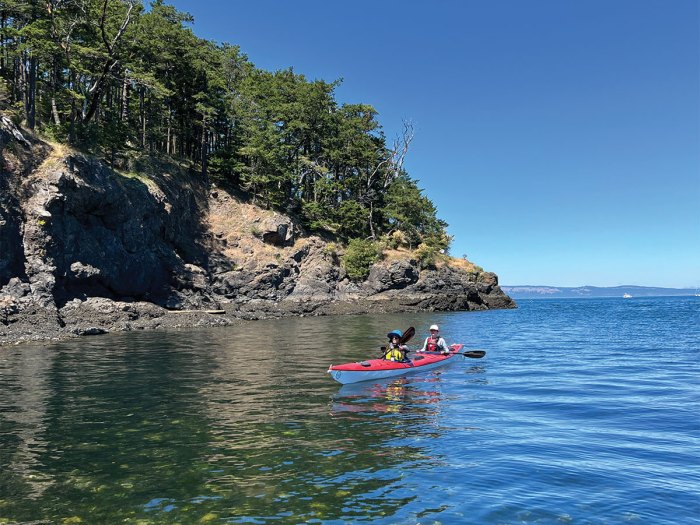
Savannah Maykranz (front) and Alex Baum coast to the shore at Jones Island.
“You don’t want to be all over the place,” says Dylan Turzak, 14, a Life Scout. “It definitely took a lot of teamwork.”
Teamwork helped the Scouts go more than 20 miles, stopping at forest-covered San Juan Islands, where they camped and admired the scenery. Along the way, they improved their kayaking skills and spotted wildlife, including porpoises, harbor seals and bald eagles.
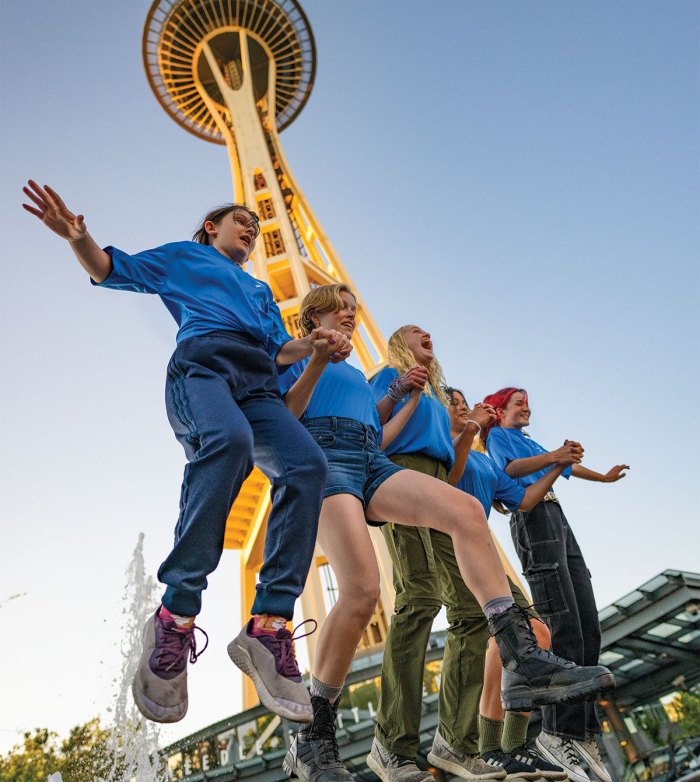
From left: Jane Jewell, Sadie Maher, Dylan Turzak, Savannah Maykranz and Alex Baum pose under the Space Needle.
STARTING IN THE EMERALD CITY
When you’re visiting a new place, you might want to go sightseeing. That’s what the troop did after arriving in Seattle last July.
Before their trek across the islands north of the city, the Scouts spent a day downtown. They stopped by the first Starbucks, established in 1971. They ducked “flying” fish, playfully tossed by employees at the Pike Place Fish Market. They dined at a Korean barbecue restaurant, and then watched the sunset from the panoramic observation room of the 605-foot-tall Space Needle.
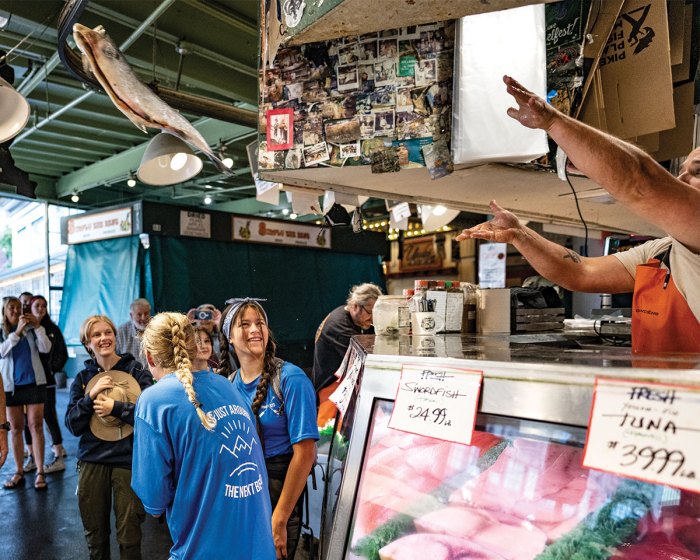
The Scouts visited Pike Place Fish Market, where workers throw fish to each other.
“That was the perfect way to start the trip,” Dylan says.
The next morning, the Scouts boarded a ferry and headed to San Juan Island, where they met an outfitter that would guide them on their journey. If you’re planning a kayaking trip, you have options with designs and materials. Some kayaks are inflatable; others are made with plastic or fiberglass soaked in resin. Designs are for different uses and water conditions, from calm flat water to rushing whitewater.
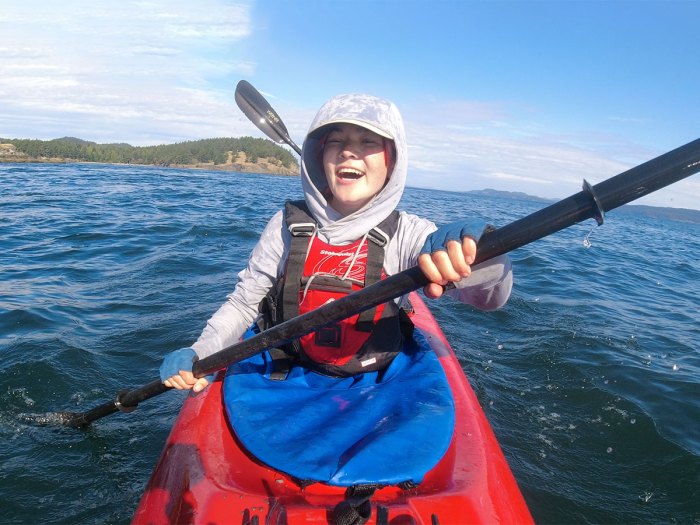
Alex Baum of Troop 673 smiles as she paddles around Washington’s San Juan Islands.
The outfitter offered 20-foot tandem kayaks, which can seat two, plus two weeks’ worth of equipment — perfect for a trek on potentially choppy waters.
“They have a surprising amount of room; they could hold several medium-sized bags,” says Tenderfoot Scout Jane Jewell, 11.
With their gear and food stowed in their vessels, the Scouts set out for Jones Island.
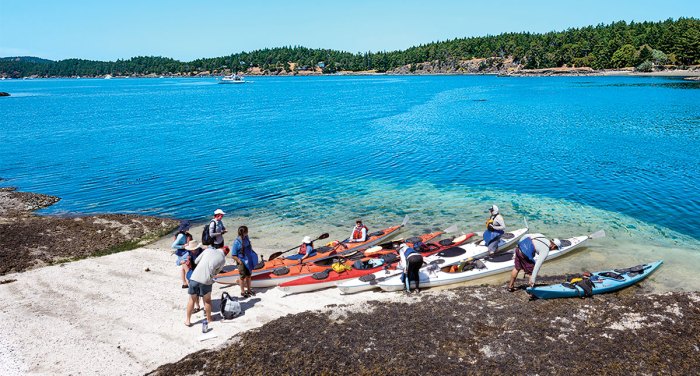
The Scouts stop for lunch at Stuart Island halfway through the trip.
BATTLING THE CURRENTS
The girls’ first stop required paddling for 8 miles, and they soon discovered how tough open-water kayaking can get.
“The currents were super crazy,” says Savannah Maykranz, 14, a Star Scout. “It was a long paddle.”
To minimize dealing with rough waters, steer along the shore, where the wind and waves are not as powerful.

The troop saw a lot of wildlife, including harbor seals.
Staying close to land also gives you more chances to see wildlife. The Scouts saw river otters, foxes and harbor seals with their pups. Later in the trip, they were surprised by porpoises that surfaced close to their boats.
“It was amazing seeing the porpoises,” Jane says. “They go up and you see the dorsal fin. It’s like living in a book.”

From left: Alex Baum, Dylan Turzak, Savannah Maykranz and Sadie Maher discuss the paddle route for the day.
ADVENTURES ASHORE
Not all the excitement happened in the water. The Scouts camped under towering evergreen trees, overlooking the sea. On Stuart Island, they hiked to a 130-year-old lighthouse, where they got a view of some Canadian islands. They also visited a shut-down schoolhouse and took time to shoot hoops at the basketball court.
“We really got to explore the island,” says Eagle Scout Alex Baum, 16. “It was a more leisurely pace.”
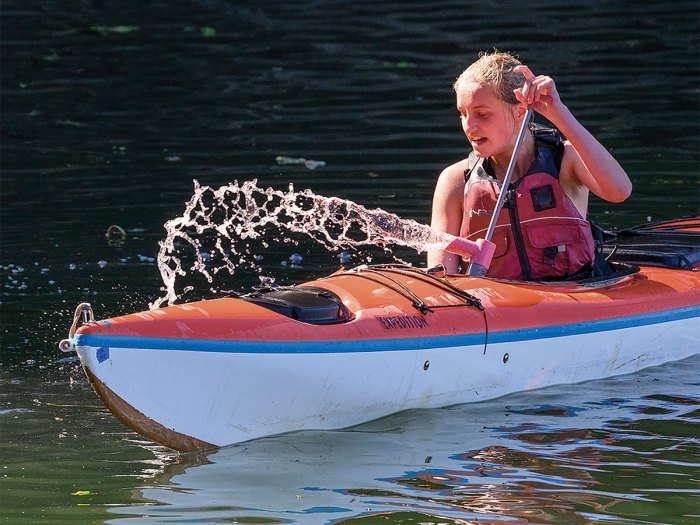
Dylan Turzak uses a bilge pump to remove water from her kayak during a practice bailout for the Kayaking merit badge.
Throughout the adventure, the Scouts worked on kayaking techniques like safely exiting a capsized kayak and maneuvering a swamped boat to shore. You can learn these skills through the Kayaking merit badge, which the girls earned.
They ended their trek with more sightseeing — this time at Miners Landing in Seattle, where they rode a Ferris wheel and grabbed some souvenirs.
“It was the best Scout trip I’ve ever done,” says Life Scout Sadie Maher, 16.”
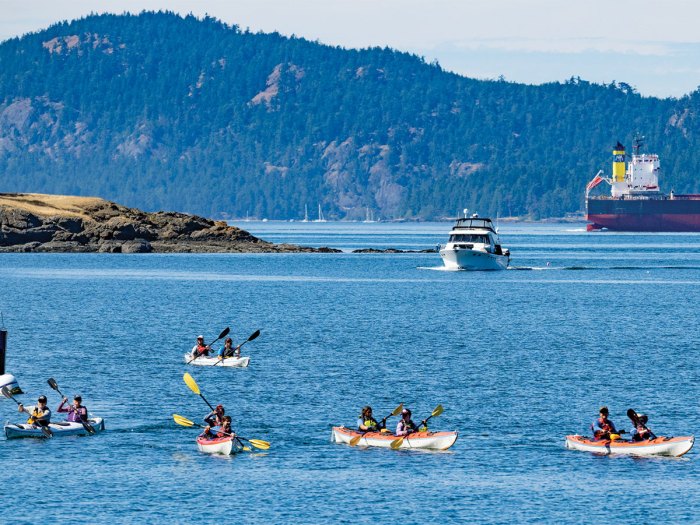
The group paddles into Roche Harbor at the end of the trip. Everyone was looking forward to showers, pizza and soft beds.
Know Before You Go
Kayaking can be fun when done safely. Before hopping in a vessel, you must wear a properly fitted U.S. Coast Guard-approved personal flotation device and use the buddy system.
Practice in flat water, working on fundamental skills. Cub Scouts as young as Wolves can paddle a kayak on flat water. However, float trips, which require training in reading the environment, using emergency equipment and communicating with fellow kayakers, are more appropriate for older, experienced Scouts. Refer to BSA Safety Afloat for more guidance.
Remember to follow the directions of the qualified adults supervising.
Finding Killer Whales
Orcas, also called killer whales, stand out as the ocean’s top predator. Highly intelligent, weighing up to 11 tons and armed with 3-inch-long teeth, they feast on fish, squid, seals, sharks (including the great white) and other whales.
Troop 673 didn’t see any whales during the trek, but orcas are often spotted where the Scouts were. Killer whales live in every ocean and travel in groups, called “pods,” of up to 50.
They follow the food, and the Pacific Northwest is rich in salmon. That can make it difficult to predict when and where to see them, especially since the whales can swim 100 miles in a day.
In that part of North America, the best times for whale-watching are usually summer and autumn months, which are salmon-spawning season.
Aquatic Awards
The BSA offers special aquatic skills awards for activities like scuba diving, stand-up paddleboarding and kayaking. Check the Guide to Awards and Insignia for more awards to earn on your next aquatic adventure.
Leave a Comment